Samsung Galaxy Tab 2 7.0 review
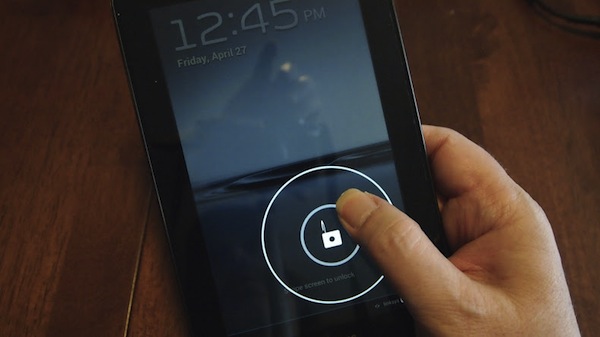
I really like reviewing products, but don’t have the time or patience to measure battery life or benchmark the CPU, etc. I'm more interested in how a product like Galaxy Tab 2 7.0 fits in the scheme of things. How it suits real people.
So far, I think this tablet has gotten an unfair shake among major media. But the reviews at shopping sites tell the real story. This is a nice little tablet. The price is right, too, and it comes with Android 4.0 (aka Ice Cream Sandwich).
A Real Delight
Inside the standard white, tight-fit Samsung cardboard box there are no surprises. You get the unit, a charging cable, and an AC adapter. No headphones. I prefer it that way, as I have a nice set of headphones, and I’d rather take the cost out of the unit. There’s a manual, but I imagine it’s a giant cut and paste of everything the lawyers made Samsung put in the box. Leave it in the box with the receipt from the store or Amazon.
I’ll get right to the bad news, probably the worst thing I can tell you about the Galaxy Tab 2 7.0. I don’t think other reviews mentioned this (see list later on). Samsung preloads the tablet with a lot of software. A LOT. And pre-loaded software, unlike a PC, can’t be deleted. It can only be disabled, which is simple to do. So when you open up the Storage section of the Settings you are going to discover the 8GB on the box translates to 4.5GB of free memory. Yep, 3.5GB is tied up by Samsung’s stuff, and there’s not really anything you can do about it.
So you need to understand that if you are going to carry this thing around and use it where there is no WiFi you’re going to have to pick up one of these, too, to expand the storage. So add $25 to the price of the unit to have a healthy amount of space to work when disconnected. If you are going to be in WiFi most of the time you’re in luck. You get 50GB of free Dropbox space for a year with this unit. Google Music allows you to load 20,000 songs that can be downloaded on demand.
Just be sure and turn the machine off and on every other week, and you’ll be fine.
Galaxy Tab 2 7.0 has a front VGA camera and a back 3-megapixel camera. The software shutter button has almost no lag at all, which is a big improvement over the Tab 8.9. Photo quality is good enough for web work but not astounding. Don’t buy this tablet to replace your camera (why would you anyway?) but it does a fine job at what I use Galaxy Tab cameras for, mostly for reference shots and copying things I’m too lazy to write down, or grabbing a business card on the go so I can impress the person handing me the business card by handing it back.
The camera also is great for catching moments when there’s nothing else to shoot with. It improves dramatically when the amount of light increases. The camera also has a lot of the standard Samsung perks, like the ability to take a panorama picture, which is great for getting the inside or outside of a business.
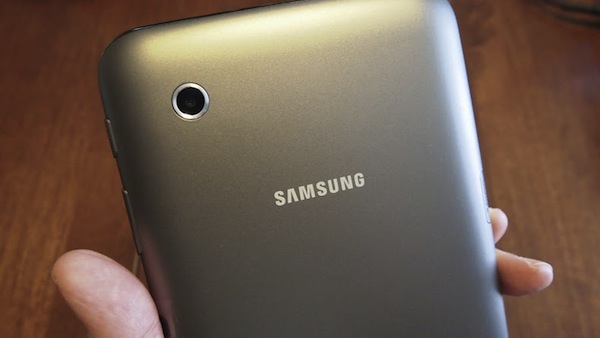
A Fine Heritage
Before I go on with the rest of the review, let me drag you through a brief history lesson. It's important context for Galaxy Tab 2 7.0's size.
The first tablet I can think of is the Newton. At the time it was awesome, but nobody could afford it, until it failed. That’s when I got mine. I had it about 3 days, then realized for the time being paper and pencil were safe. Pinnacle of tech between then and now was the Palm Pilot, which abandoned recognizing handwriting for teaching you a new way to write. The small size and the fact that it ran for a month on a pair of AA batteries made Palm Pilot great. If you were a hardcore user you eventually lost the ability to read your own handwriting.
But like the Newton, Palm Pilot primarily did one thing -- it was a day planner. It beeped when you were supposed to do something and put your Outlook calendar in your pocket.
Sometime in the past the mini-tablet leapt to the phone, and while Windows versions were excessively complicated and Palms were hopelessly underpowered that created the vacuum for the iPhone to emerge. It raised the bar.
Which leads to the iPad. The first words out of my mouth when I saw the iPad? "It’s too big" A wave of Steve Jobs' Jedi hand and use of the word "magical" and I bought one anyway. It was too big.
It really still is. Don’t get me wrong, iPad is a great lap tablet. When you're nestled in something that supports you to support it, it’s fine. When you have to tote, retrieve and work with it all day long, it gets unwieldy at times.
The Right Fit
Samsung decided to try to capitalize on this shortcoming and released a 7-inch tablet, the Galaxy Tab. It was the perfect size but had basic problems. It was too heavy, wasn’t that comfortable to hold and had iPad-style square edges. It had a version of Android prone to freeze ups, and when the Gallery app went South you just couldn’t fix it with a reset or anything. At least that’s how it went for me.
Still Galaxy Tab was the right size. Fortunately Samsung didn’t give up and today we have the Galaxy Tab 2 7.0. Let’s hit the high points. The curved plastic back solves two problems: The device feels better in your hand, and it’s lighter.
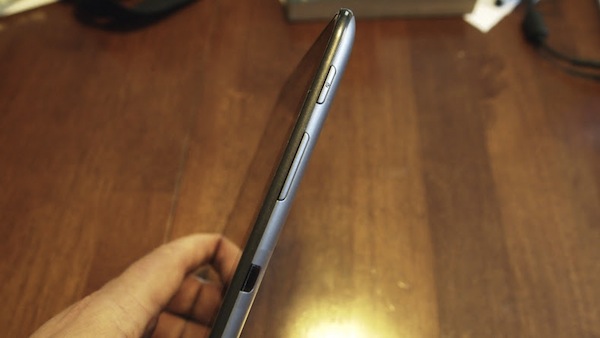
Some people have problems with the plastic back but let me tell you, build quality on this unit is nice. The back feels solid and the switches and buttons, too. This unit is built to last. Given the volatile nature of technology, this tablet will outlast its relevance and will be handed down (rather than thrown away) to make way for newer tech.
Ample Resolution
The screen is the same resolution as previous 7-inch GTs, WSVGA (1024 x 600), and that is plenty for much of what you would use a book-sized tablet for. It’s okay for reading a book. Okay to use as a day planner. Okay to watch a movie or TV show. Irrelevant when listening to music. Honestly, no tablet needs to be super high-resolution for one obvious reason: your fingers can only be so small. At some point if the resolution is high enough you can’t tap something with any certainty. I experienced that first hand with the new iPad when I had a heck of time tapping between specific letters.
The color fidelity of the screen is good and because it’s 7-inches with WSVGA, it has a good apparent resolution. It’s not pixel invisible like the “resolutionary” new iPad but it’s very close to the 100DPI limit the eye can perceive and you are not trying to schlep 3.1 megapixels when you just want to see the next headline on Feedly.
It only took a few seconds with the store demo unit to realize the screen was going to be fine for everyday use.
Now about speed. I never had or used a Galaxy Tab 7 Plus, which is supposedly faster but I did have a Galaxy Tab 8.9, and this feels much faster than it. The page flips in the launcher are fast and my true speed test worked just fine. I load Autodesk Sketch Plus and draw a long continous swirl as fast as I can. If the screen tracks and there are no skips in the line - it passes. The Tab 2 handled my speed test just fine. All of the apps I loaded performed better than on the 8.9 and no real noticeable lag even with a Bluetooth keyboard.
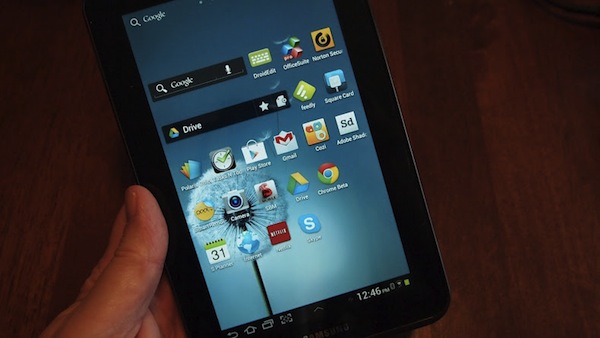
Ice Cream Sandwich
It’s hard to review a device that has an OS without talking a bit about the OS.
This, I believe, is the first Samsung to ship with Ice Cream Sandwich. Ice Cream Sandwich, which is different than Honeycomb (Android 3.x) but I don’t care what the OS technically is, I care about what it does. It still has soft buttons at the bottom of the screen, instead of hardware buttons and overall seems to run faster.
The first Galaxy Tab I owned ran Froyo (Android 2.20, which was pre-Gingerbread (Android 2.3). It was only two years ago but seems like the Stone Age. For the most part the apps back then were mostly Java-based layouts, and while they would capture the data the UI was kind of Fisher Price My First Tablet looking. Add that apps crashed a lot, and it was a labor of love to like the unit, especially with the ridiculous overly ambitious 3-D wall Gallery app that choked on your Picasa photos (by the way I do not recommend syncing your photos to your tablet; use the Dropbox autoupload instead). Most apps made your Galaxy Tab 1 look like a big freaking phone.
Fast forward to the Tab 2 7.0 and you have a very different experience. There are lots of newer apps with a much nicer interface and are more intuitive to use. They look better on the screen (Samsung has installed a Helv Neue font on this device) and there is no apparent performance penalty. I don’t know if this is because apps are more HTML 5 and less Java these days or not but regardless you’ll have a much better experience using this and other ICS device(s).
One minor annoyance, and I don’t know if this is ICS or Samsung’s Launcher, you can only use a subset of the screen for icons and widgets in the Launcher, which is a square portion of the screen that is the same portrait or landscape. In portrait mode there are two fairly large pieces of unused screen above and below your widgets and icons -- mildly annoying to me because I like to try to jam everything on the main screen (yep OCD). Because the Launcher is so fast on the Tab 2, and I want to preserve as much space as possible on the primary SD, I initially didn't load Go Launcher EX. When I did, it was slower than TouchWiz -- uninstalled.
Probably the ICS nicest perk: You can download and install Chrome for Android beta from Google Play store. This gives you the ability to sync your bookmarks in the background as well as have your open tabs move. Along with Google Drive, this makes any Android tablet a much better work device.
I need to point out the difference between Android and iOS as well.
You can write an application on your PC or Mac and install it on your Android device and run it. No developer fees. You can copy over a ton of material to a MicroSD card and load it into your device and watch, listen or read it. You don’t have to cloud it anywhere. It just goes straight from your PC to your Tablet. No trips to Cupertino, Calif. to get to Collinsville, MS.
That’s a big deal.
I can’t tell you how good a 3-D gamer machine this I don’t play them. I suspect it’s not the Droid you want in that department.
The Price is Right
So let’s talk about the most important feature of this unit. It’s the price. $249 USD. That’s really a deal. Subtract the $99 worth of Dropbox you are getting for free (which takes the sting out of the 4.5GB thing I opened with) and it’s actually less than the Kindle Fire ($199 USD). Let’s break that price down a bit.
The Tab 2 costs:
- 60 Big Macs
- 35 high-end domestic beer 6 packs
- 1.5 college textbooks
The new (too big) iPad -- that's the $499 one -- costs:
- 118 Big Macs
- 3 college textbooks
So it only takes 2 months of Ramen to pay for your Galaxy Tab 2 7.0.
This price point and the feature set make this, IMHO, the perfect wired campus companion. It’s also the perfect tablet for the person who goes home to a WiFi’d house from an open or guest WiFi’d workplace. It’s a great coffeshop device, too. It’s a good tool to get your life organized. Those are things that really appeal to me about this unit.
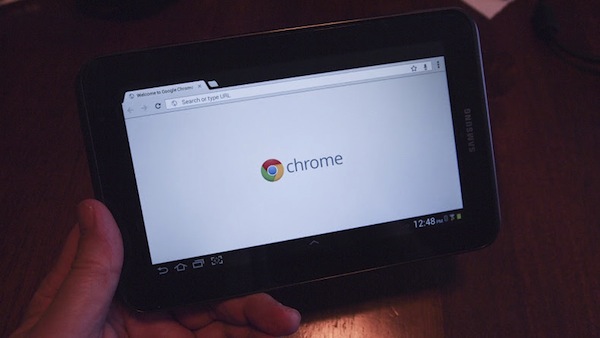
When the Kindle Fire came out at $199 price point, I was ecstatic -- finally a device that was affordable to lot more people. It only took reading the specs a few minutes to realize this was a shopping cart that played movies, books, music and selected games. It was a closed environment that required being in the Amazon App store to market to. It was the Apple model all over again.
Now with the Galaxy Tab, we have a device at a price point that is a smidge higher but with a lot more potential. It’s more open. If this is not the device that kills the textbook, then its next iteration will. This is what we need for education, and education is what we need to make the world a better place (steps down from his soapbox).
Closing Thoughts
Galaxy Tab 2 7.0's smaller size means littler hands can type on it easily in portrait mode. It’s light enough and comfortable enough to hold for a while. The applications available are good enough to manage your life, and even start an Internet business with (with the occasional help of a borrowed desktop). With Chrome and Google Drive installed, your stuff moves with you making anywhere you can get to Chrome -- desktop, laptop, Chromebook; Windows, OS X, Chrome OS.
You could easily create a USB flash drive Linux computer, install Chrome and carry everything with you in a sandwich bag. As an aspiring minimalist that has big appeal.
There are apps that allow you to create documents (you can even pair a Bluetooth keyboard), and you can code on it with an app like Droid Edit. You can remote into Windows and OSX machines with an app like PocketCloud if you needed to.
So when you first look at the storage and see you are down 3.5GBs out of the gate, you quickly get over the heartburn as you use the unit and see it still has plenty of room for more stuff. The performance of the unit is solid and it feels good in the hands. With moderate use I get two days between charges (see the other reviews for actual test).
Spot checking Amazon reviews, it gets 4 stars and many buyers echo my sentiments. The pros don't necessarily agree. Some of their reviews:
Among these five reviews, you can find your deep geek questions answered in full. In the interest of full disclosure I read most of them before buying my Galaxy Tab 2 7.0.
I don’t think you’ll be disappointed with this device and, yes, someone will announce a new and better tablet 2 weeks after you buy this one. Don’t let that stop you. Galaxy Tab 2 7.0 will be quite useful for a very long time.
Photo Credits: Clay Hamilton
 Clay Hamilton is a web producer, educator and writer.
Clay Hamilton is a web producer, educator and writer.